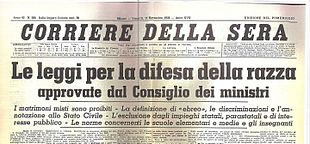Italian racial laws

The Italian racial laws, otherwise referred to as the Racial Laws (Italian: Leggi Razziali), were a series of laws promulgated by the government of Benito Mussolini in Fascist Italy from 1938 to 1944 in order to enforce racial discrimination and segregation in the Kingdom of Italy. The main victims of the Racial Laws were Italian Jews and the African inhabitants of the Italian Empire.[1][2][3]
In the aftermath of Mussolini's fall from power and the invasion of Italy by Germany, the Badoglio government suppressed the laws in January 1944. In northern Italy, they remained in force and were made more severe in the territories ruled by the Italian Social Republic until the end of the Second World War.[2]
History
| ||
|---|---|---|
|
||

The first and most important of the Racial Laws (Leggi Razziali) was the Regio Decreto 17 Novembre 1938, Nr. 1728. It restricted the civil rights of
The promulgation of the Racial Laws was preceded by a long press campaign and publication of the "Manifesto of Race" earlier in 1938, a purportedly-scientific report signed by scientists and supporters of the National Fascist Party (PNF); among the 180 signers of the "Manifesto of Race" were two medical doctors (S. Visco and N. Fende), an anthropologist (L. Cipriani), a zoologist (E. Zavattari), and a statistician (F. Savorgnan).[4] The "Manifesto of Race", published in July 1938, declared the Italians to be descendants of the Aryan race.[1] It targeted races that were seen as inferior (i.e. not of Aryan descent). In particular, Jews were banned from many professions.[1] Under the Racial Laws, sexual relations and marriages between Italians, Jews, and Africans were forbidden.[1] Jews were banned from positions in banking, government, and education, as well as having their properties confiscated.[5][6]
The final decision about the Racial Laws was made during the meeting of the

While some scholars argue that this was an attempt by Mussolini to curry favour with
Criticism and unpopularity
| Part of a series of articles on |
| Racial and ethnic segregation |
|---|
 |
Leading members of the National Fascist Party (PNF), such as Dino Grandi and Italo Balbo, reportedly opposed the Racial Laws,[14] and the laws were unpopular with most Italian citizens; the Jews were a small minority in Italy and had integrated deeply into Italian society and culture over the course of several centuries.
Most Jews in Italy were either descendants of the ancient
, where Jews had more presence and lived in large numbers for a long period of time.During the
Indeed, prior to 1938 and the Pact of Steel alliance, Mussolini and many notable Italian Fascists had been highly critical of
In 1929, Mussolini noted that Italian Jews had been a demographically small yet culturally integral part of Italian society since Ancient Rome. His views on Italian Jews were consistent with his early
Historian Federico Chabod argued that the introduction of the Nordicist-influenced Racial Laws was a large factor in the decrease of public support among Italians for Fascist Italy, and many Italians viewed the Racial Laws as an obvious imposition or intrusion of German values into Italian culture, and a sign that Mussolini's power and the Fascist regime were collapsing under Nazi German influence.[15][17]
See also
- An Investigation of Global Policy with the Yamato Race as Nucleus
- Antisemitism in 21st-century Italy
- "Fascist Manifesto"
- History of the Jews in Italy
- Italian fascism and racism
- Italian war crimes
- Lebensraum
- "Manifesto of Race"
- Mediterranean race
- Nazi racial theories
- Nuremberg Laws
- Race Life of the Aryan Peoples
- Racism in Italy
- Racial policy of Nazi Germany
- The Garden of the Finzi-Continis
- The Holocaust in Italy
- Three Aspects of the Jewish Problem
References
- ^ S2CID 201401541.
- ^ ISBN 9780415290159.
- ^ OCLC 1122565258.
- ISBN 9788816409071.
- ^ ISBN 978-0-230-80267-4.
- ISBN 978-0-521-84515-1.
- ISBN 978-0520071995
- ^ Joshua D. Zimmerman, Jews in Italy Under Fascist and Nazi Rule, 1922-1945, pp. 119-120
- S2CID 143652167.
- S2CID 161818702.
- S2CID 143799280.
- S2CID 143090861.
- ^ ISSN 1469-9583.
- ^ Gunther, John (1940). Inside Europe. New York: Harper & Brothers. p. 262.
- ^ ISBN 978-9004212558. Retrieved 9 January 2016.
- ^ a b Neocleous, Mark. Fascism. Minneapolis, Minnesota, USA: University of Minnesota Press, 1997. p. 35
- ISBN 978-0618794263.
Bibliography
- ISBN 8806172794.
- Bianco, Giovanni (2016), Razzismi contemporanei, in: Rivista critica del diritto privato, Esi, Napoli, n. 2/2016, ISSN 1123-1025
- Burgio, Alberto (2002), Nel nome della razza. Il razzismo nella storia d'Italia, Il Mulino, Bologna,ISBN 88-15-07200-4
- Centro Furio Jesi (a cura di) (1994), La menzogna della razza. Documenti e immagini del razzismo e dell'antisemitismo fascista, Grafis, Bologna, ISBN 888081009X
- Michael A. Livingston: The Fascists and the Jews of Italy – Mussolini´s Race Laws, 1938–1943. Cambridge University Press, 2014, ISBN 978-1-107-02756-5.
- Furio Moroni: Italy: Aspects of the Unbeautiful Life. In: Avi Beker: The Plunder of Jewish Property during the Holocaust. Palgrave, 2001, ISBN 0-333-76064-6.
- Michele Sarfatti: Characteristics and Objectives of the Anti-Jewish Racial Laws in Fascist Italy, 1938-1943. In: Joshua D. Zimmerman: Jews in Italy under Fascist and Nazi Rule, 1922–1945. Cambridge University Press, 2005, ISBN 0-521-84101-1.
External links
- "Dichiarazione sulla razza – 1938" (in Italian). Rome: Associazione Nazionale Partigiani d'Italia. 21 March 2016. Archived from the original on 7 February 2022. Retrieved 15 May 2022.
- Adler, Franklin H. (Fall 2013). from the original on 30 March 2014. Retrieved 15 May 2022.
- Campus, Leonardo (29 November 2023). "Confronting History. Italian Racial Laws: Memory, Television, Historiography".

